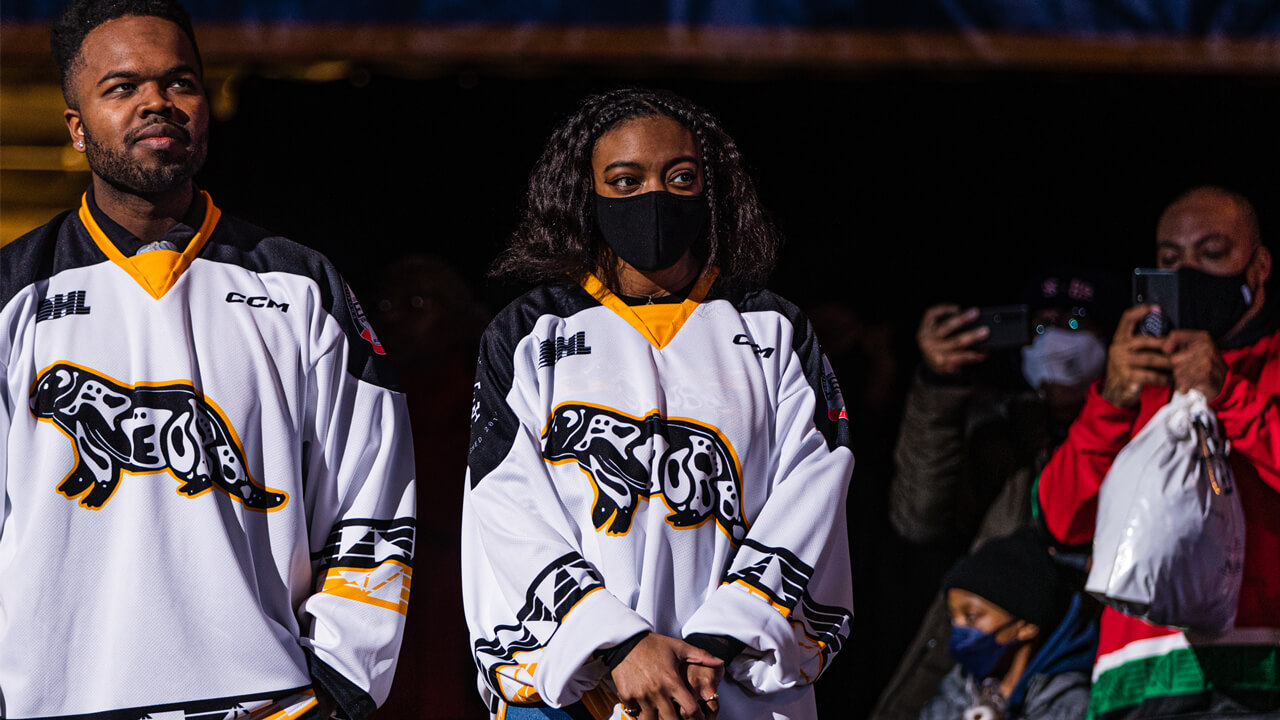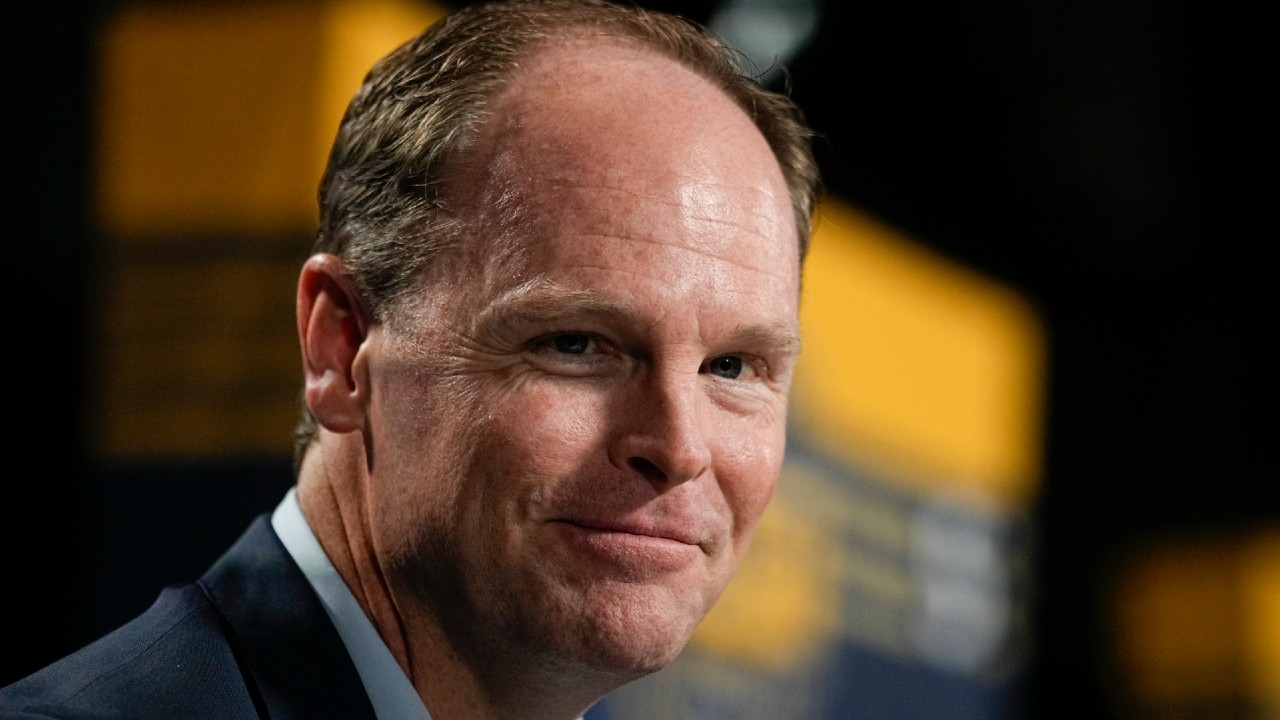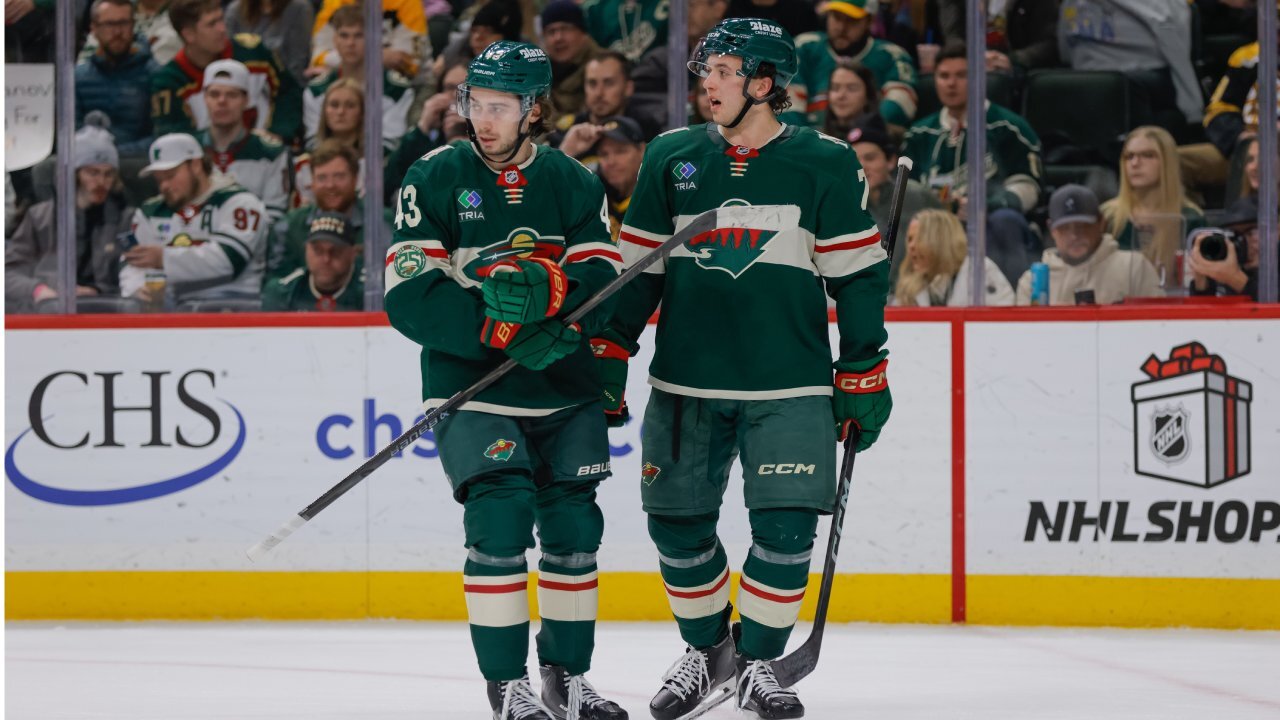
“I WANT TO CREATE THINGS THAT MAKE PEOPLE FEEL SAFER IN HOCKEY”

I
t started with a single image. A hockey player with his head bowed, his fist raised. The shading of his skin, his locks, his jersey, distilled to digitally rendered geometric shards. Across the front of his chest, in white curling letters, three words: ‘Black Lives Matter.’
It was the first illustration Jo Dabney shared with the hockey world, a 2020 piece inspired by former NHLer JT Brown’s protest during the American national anthem three years prior. When Dabney posted it to her social media, there was no grand plan, no vision of her art creating wider ripples throughout the hockey world or the piece launching a career.
There was just a desire to create.
“I think, out of all the things I’ve done, that’s probably been my favourite,” Dabney says now. “Because I had no intention or anything behind it. … It was kind of just, ‘What if I did this, and one person saw it?’
“And then that one person sees it, and thousands of other people see it, and I’m like, ‘Oh, this is bigger than I thought.’”
It turned out to be much bigger. The piece caught fire online, shared widely among hockey fans searching for something to connect to as the sport underwent a period of reflection and reckoning in 2020, with hockey’s overall lack of diversity put under the microscope.
And as others picked up her piece and ran with it, Dabney, too, was carried onto an unexpected path.
In the years since, she’s created artwork for the National Hockey League’s Colorado Avalanche, for Black Girl Hockey Club, for the National Women’s Soccer League. She’s designed a jersey for the Premier Hockey Federation’s Metropolitan Riveters — a project that sparked an overwhelming outpouring of praise and support from fans and players across the sport — and another for the Ontario Hockey League’s Erie Otters, which was released earlier this month.
The recent run of success was never the plan, Dabney says. Then again, neither was falling in love with hockey.
“I didn’t get into hockey when I was super young — I was more of a baseball fan growing up,” she says of her days as a young sports fan in Washington D.C. “When I was around 12 or 13, I watched The Mighty Ducks.”
It was the antics of Charlie Conway, Gordon Bombay and their Flying V that hooked her.
“I Googled local hockey teams, and the Caps were the only team that came up. So I was like, ‘Okay, I’ll be a fan of them,’” she remembers. “I didn’t really have any hockey friends at that point. Up until 2019, I didn’t know anyone in hockey, or anyone who followed the sport. It was mostly just through watching games, watching YouTube videos, reading a bunch of books on it, kind of keeping it to myself. Until I joined Twitter.”

The tumble into working as an illustrator, into loving art at all, was just as unexpected.
In the beginning, before Dabney was designing pieces for some of the top hockey leagues in the world, her artistic aspirations were much simpler, her audience much smaller.
“I only really started doing art — when I was around five or six — because of my older brother. I thought he was the coolest person in the world,” she says. Back then, the point of creating was clear: it was a way to connect, it was a bridge between her and family.
“It turned into me making art on my own, and I would eventually show him. If he thought it was cool, that was the coolest, best moment for me.
“At some point, it turned into drawing hockey players.”
In 2020, the two passions overlapped — Dabney posting her JT Brown illustration online, then going to donate blood and missing the initial reaction to her piece, only to log on later to a cascade of Twitter notifications.
The piece allowed Dabney to connect with Brown himself — the seven-year NHL vet adopting her creation as his profile picture for a time — and to join Black Girl Hockey Club as the organization’s resident graphic designer.
It was through that new role that she found herself causing ripples throughout the hockey world yet again two years later. This time, though, Dabney’s creation wasn’t posted in a tweet — it was printed on jerseys, donned by players, woven into the history of a professional franchise.
The 2022 project was the culmination of a dedicated effort from journalist Erica Ayala, who pushed for the Riveters to create a version of their logo — a take on the iconic ‘Rosie the Riveter’ image, representing the essential role women played in America’s workforce during World War II — that celebrated Black women’s heroism, too.
Embracing the idea, the club reached out to Dabney to create Black Rosie, and agreed to donate profits from the jerseys to Black Girl Hockey Club. So well-received was the eventual design, the Riveters wound up launching a full merch line featuring Black Rosie — stamping Dabney’s art on all manner of clothing items — before donning the sweater for a game in February 2022.
But among all those in the sport who wore the jersey, the T-shirts and hoodies, who sent her messages about her design — she still gets photos of fans wearing the threads a year later — there was one who stood out from the crowd: Braden Holtby, member of the 2018 Cup-winning Capitals, and Dabney’s all-time favourite player.
“The sound I made when I checked my phone and saw Braden Holtby’s face and something that I made — I don’t know, I wish I had the words for it,” Dabney says. “My favourite player — the player who kept me passionate about the sport, this amazing player — is a fan of my work. Like, I’m a fan of him and he’s a fan of me.
“Even to this day, I can’t really describe how that makes me feel. It just makes me smile.”
The love for Dabney’s Black Rosie granted her more opportunities to work in the sport, to spread her art. But the die-hard Caps fan was careful to ensure working in hockey didn’t interfere with loving hockey.
“I didn’t, and [still]don’t, want to lose the part of myself that is just a hardcore fan. I would give any and everything to go to a game and watch my team win,” she says. “When it started, it was more of picking the right jobs and working with the right people, more as a fan.”
That meant teams that were on-ice rivals of her Capitals didn’t get a long look. Eventually, though, the criteria shifted to the bigger picture.
“Now it’s more looking at teams that work towards the vision of what I want hockey to be like,” Dabney says. “Teams that really show they’re about inclusivity, about protecting and creating certain spaces for certain fans that are often neglected.”
Even so, Dabney can’t help but let her unbridled love for the game, for her team, guide her path now and again. And it was her dedication to the Caps that led her to her latest triumph.
Late last year, when the Erie Otters put out a call for designs for a special Black History Month jersey, Dabney had no intention of throwing her name into the ring, having taken a break from drawing and from social media, the combination leaving her feeling disconnected from the sport.
But a thought occurred to her: another beloved former Capital, Andre Burakovsky, had once suited up in an Otters sweater.
“Then, a few weeks later, I heard that Dylan Strome — who had also been an Erie Otter — signed for the Caps. I was like, ‘This is a sign,’” she says. “‘I don’t know what the connection here is, but this is a sign that I should do something for the Erie Otters.’”
She went to work on the design — a yellow outline of an otter that incorporated within it a ‘B’ to represent Black excellence, an ‘E’ and an ‘O’ to represent the club’s name, 96 dispersed dots paying tribute to the club’s founding year, and a pattern that spoke to Dabney’s own philosophy when it comes to Black History Month creations.
“One of the things that’s a tiny little pet-peeve of mine, one of the things that gets me about Black history designs, is the recreation of traditional African patterns,” she explains. “A lot of Black North Americans don’t know our African ancestry, so it seems a little weird to just kind of recreate something that we’re not even sure we’re from, specifically. So, I always try and create my own patterns. That way, I can say it’s an actual Black American pattern, because I made it.”
In January, the Otters announced Dabney’s design as the one they’d wear on Martin Luther King Jr. Day. Dabney was on hand at Erie Insurance Arena to drop a ceremonial puck, wearing the threads she created, the Otters skating warm-up circles on the ice wearing them, too.
Another surreal moment, just three years into a wild journey she’d never planned on taking.
If there’s one thing that’s become clear the further that journey’s progressed, though, it’s the capacity of Dabney’s work to connect hockey with communities that have long been under-represented in the sport. While discussions of hockey reaching out to more communities often focus on funding and equipment drives and on-ice training, those efforts comprise only part of a bigger picture.
Art can be a vessel for spreading the love of the game, too, she says. Of allowing new fans to simply feel part of it.
“I definitely think there’s more than one way that hockey can not only grow the sport, but get more younger people into it,” she says. “One thing I feel hockey lacks is embracing art in different ways. Because art is around us in so many ways — jersey designs, posters, arena paintings, murals.
“Connecting through art with other people creates a sense of community, and I feel like hockey kind of lacks the overall sense of community that brings people together beyond your own team.”
In her own way, Dabney’s beginning to change that, building a bridge between her love of the sport and those who are just beginning to experience it — just like another bridge she built through her art all those years ago.
Where her journey in the game goes from here is anyone’s guess, she says, though there are some in-the-works projects still to debut later this year. But for Dabney, there are no lofty goals to live up to, no charted path to navigate.
There’s just a singular hope for the impact her work can have, when all is said and done.
“I want to create things that make people feel safer in hockey. Even if it’s just a drawing or a jersey,” she says. “Even if it’s something people outside my own personal bubble don’t enjoy, I’m okay with that. As long as the people it does have the potential to impact enjoy it, then I feel like that’s enough.
“Helping other people enjoy the sport that I love, the way that I love it, it’s amazing. There are kids that probably never knew about hockey. And one day they’ll see a Black Rosie jersey, and they’ll see Black people in hockey. That is more than enough for me.”
James DiCioccio/Erie Otters; Courtesy Jo Dabney






